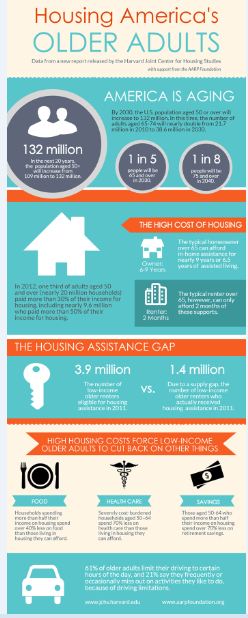AARP Eye Center
Harvard Report: U.S. 'Unprepared' to House Coming Wave of Older Adults
By Melissa Stanton, September 2, 2014 01:35 PM

We've known for a long time that the U.S. population is rapidly aging due to increased longevity and the boomer population (all of whom will be 50-plus this year).
The report "Housing America's Older Adults: Meeting the Needs of an Aging Population," released today by the Harvard Joint Center for Housing Studies (with support of the AARP Foundation), makes very clear that both individually and as a nation we're not ready for all that comes with age.
Sign up for the Livable Communities Newsletter
The existing housing stock is "unprepared to meet the escalating need for affordability, accessibility, social connectivity, and supportive services," say the authors. The nation's transportation and pedestrian infrastructure "is generally ill-suited to those who cannot or choose not to drive, isolating older adults from friends and family."
Not only that, "disconnects between housing programs and the health care system put many older adults with disabilities or long-term care needs at risk of premature institutionalization."
To make matters worse, many older adults simply can't afford to be old. Some stats and facts:
- The typical homeowner over 65 can afford in-home assistance for roughly 6 to 9 years of assisted living
- The typical renter over 65 can only afford two months of support
- In 2012, one-third of adults age 50 and older paid more than 30 percent of their income for housing, including nearly 9.6 million who paid more than 50 percent of their income for housing
- High housing costs cause low-income older adults to cut back significantly on food, health care and retirement savings
Read the full report (PDF), checkout "5 Essential Facts" from the report, see the infographic up close and visit an interactive map showing how the U.S. population has aged significantly over the past two decades. Following are a few examples of county data for people age 50 and older. You can look up the information for where you live.
- Cheyenne County, Kan. (41.4 percent in 1990 vs. 50 percent in 2010)
- Shelby County, Ill. (33 percent in 1990 vs. 40.5 in 2010)
- Choctaw County, Ala. (27.8 in 1990 vs. 40.2 in 2010)
- Suffolk County (Long Island), N.Y. (25.1 in 1990 vs. 33.3 in 2010)
- Mendocino County, Calif., 26.7 in 1990 vs. 39.4 in 2010)
Although aging is inevitable, a dour outlook needn't be. Explains the report: "While there are significant challenges ahead, the potential is there for older adults to have a higher quality of life than ever before, and for communities to be increasingly livable and vibrant as a result. But effective action will require concerted efforts at all levels of government as well as by the private and nonprofit sectors, and through the advocacy of older adults themselves."
Adds Lisa Marsh Ryerson, president of AARP Foundation: “As the report points out, promising approaches have already emerged, and they are giving us a path for moving forward. This report is far from doom and gloom. Yes, we have serious issues to tackle, but there is still time to do so, if we begin acting now.”
Visit aarp.org/livable and aarp.org/age-friendly to learn how AARP is working to help towns, cities and even states become more age-friendly and livable for people of all ages.
----------------------------------------------------------------------------------------------------------------------------------------------------

Melissa Stanton is a project manager and editor on the AARP Livable Communities Team.
Subscribe to the Livable Communities Great Places Blog by email or RSS feed
Follow us on Twitter @LivableCmnty
Learn more about livable communities at AARP.org/livable
Stay Informed: Sign up for the Livable Communities Newsletter























































